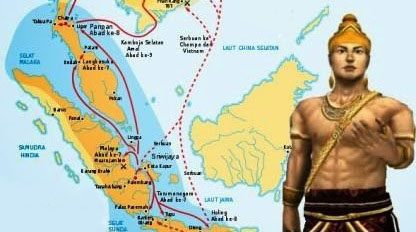Sri Maharaja Balaputradewa was a member of the Sailendra dynasty who became king of the Srivijaya Kingdom .
Origins
According to Nalanda’s inscription, Balaputradewa was the grandson of a Javanese king who was nicknamed Wirawairimathana ( killer enemy officers). His grandfather’s nickname is similar to Wairiwarawimardana alias Dharanindra in the Kelurak inscription . In other words, Balaputradewa is the grandson of Dharanindra .
Balaputradewa’s father was named Samaragrawira , while his mother was Dewi Tara, daughter of Sri Dharmasetu of the Soma dynasty . The Nalanda inscription itself shows the friendship between Balaputradewa and Dewapaladewa the king of India , which is marked by the construction of a monastery initiated by Balaputradewa in the Bengal region .
Withdrew from Java
A very popular theory, developed by De Casparis, states that Samaragrawira is identical with Samaratungga, the king of Java . After the death of Samaratungga there was a struggle for the throne between his two sons, namely Balaputradewa against Pramodawardhani . In 856 Balaputradewa was defeated by Rakai Pikatan, Pramodawardhani’s husband, and fled to the island of Sumatra .
This theory was refuted by Slamet Muljana because according to the Malang inscription, Samaratungga only had a daughter named Pramodawardhani . According to him, Balaputradewa is more accurately called Samaratungga’s younger brother . In other words, Samaratungga is the eldest son of Samaragrawira , while Balaputradewa is his youngest son.
The expulsion of Balaputradewa was generally based on the Wantil inscription that there had been a war between Rakai Mamrati Sang Jatiningrat (aka Rakai Pikatan ) against an enemy who had built a fortress in the form of heaps of stones. In the inscription found the term Walaputra which is considered synonymous with Balaputradewa.
This popular theory was refuted by Pusponegoro and Notosutanto that the term Walaputra is not synonymous with Balaputradewa. Instead, the term Walaputra means “the youngest son”, namely Rakai Kayuwangi who is praised for defeating the kingdom’s enemies. Meanwhile, Rakai Kayuwangi is the youngest son of Rakai Pikatan who managed to defeat his father’s enemy.
The rock pile fort which is suspected as the headquarters of the Balaputradewa rebellion is identical to Ratu Baka hill. However, the inscriptions found in the area did not mention Balaputradewa’s name, but instead mentioned Rakai Walaing Mpu Kumbhayoni . So, Rakai Pikatan ‘s enemy who was defeated by Rakai Kayuwangi the Walaputra turned out to be Mpu Kumbhayoni, not Balaputradewa.
According to the inscriptions, the figure Rakai Walaing Mpu Kumbhayoni claimed to be a descendant of the founder of the Medang Kingdom (namely Sanjaya ). So it is very possible if he rebelled against Rakai Pikatan as a fellow descendant of Sanjaya .
Presumably the popular theory that Balaputradewa fled to the island of Sumatra because he was urged by Rakai Pikatan is wrong. Perhaps he left the island of Java not because he lost the war, but because from the start he did not have the right to the throne of Java , considering that he was only the younger brother of Maharaja Samaratungga , not his son.
Became the King of Srivijaya
The Nalanda inscription mentions Balaputradewa as the king of Suwarnadwipa, the ancient name for the island of Sumatra . Because at that time the island of Sumatra was identical with the Srivijaya Kingdom , historians agree that Balaputradewa was the king of Srivijaya .
The most popular opinion states that Balaputradewa inherited the throne of the Srivijaya Kingdom from his maternal grandfather, namely Sri Dharmasetu . However, it turns out that Sri Dharmasetu’s name is contained in the Kelurak inscription as a subordinate of Dharanindra who was tasked with guarding the Kelurak Temple building .
So, Dharanindra reconciled with his subordinate employee, named Sri Dharmasetu through the marriage between Samaragrawira and Dewi Tara . According to the Kelurak inscription, Dharmasetu is a Javanese . So, the popular theory that he was the king of the Srivijaya Kingdom is wrong.
Balaputradewa succeeded in becoming king of the Srivijaya Kingdom not because he inherited the throne of Sri Dharmasetu, but because at that time the island of Sumatra had become the territory of the Sailendra dynasty , as was the case with Java .
Based on the analysis of the Ligor inscription, the Srivijaya Kingdom was ruled by the Sailendra dynasty since the time of Maharaja Vishnu . As a member of the Sailendra dynasty , Balaputradewa succeeded in becoming king in Sumatra, while his older brother, Samaratungga, became king in Java.
References
- Marwati Poesponegoro & Nugroho Notosusanto. 1990. Sejarah Nasional Indonesia Jilid II. Jakarta: Balai Pustaka
- Purwadi. 2007. Sejarah Raja-Raja Jawa. Yogyakarta: Media Ilmu
- Slamet Muljana. 2006. Sriwijaya (terbitan ulang 1960). Yogyakarta: LKIS
- Apakah Anda sedang mencari spesialis jasa kontraktor kolam renang Palembang, Prabumuli, Pagar Alam, Lubuk Linggau (Sumatera Selatan)?


